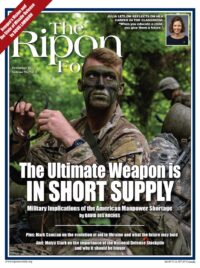
With the U.S. Space Force (USSF) marking its third anniversary this month, now is a good time to examine not only some of its key accomplishments, but some of the key challenges it faces in the years ahead.
For the most part, these accomplishments so far have been focused on creating the intellectual and organizational framework upon which this newest branch of our Armed Forces will be based. Over the past 36 months, for example, the USSF has developed the first Space Force Doctrine, a foundational document that sets forth “why spacepower is vital for our Nation, how military spacepower is employed, who military space forces are, and what military space forces value.”
The USSF also unveiled a vision for a digital service, which it says will allow it to “embrace automation and streamline bureaucracy to foster and incentivize data-driven, decision-making at every echelon.” And earlier this fall, Frank Calvelli, who serves as the Assistant Secretary of the Air Force for Space Acquisitions and Integration, issued a memorandum that lays out a new approach to acquisition. “The traditional ways of doing space acquisition must be reformed in order to add speed to our acquisitions to meet our priorities,” Calvelli said. “Former approaches of developing a small amount of large satellites, along with large monolithic ground systems taking many years to develop, can no longer be the norm.”
The USSF has developed the first Space Force Doctrine, a foundational document that sets forth “why spacepower is vital for our Nation, how military spacepower is employed, who military space forces are, and what military space forces value.”
Organizationally, the USSF is made up of three field commands and a headquarters staff. The field commands are Space Systems Command (SSC), Space Operations Command (SpOC), and Space Training and Readiness Command (STARCOM). SSC delivers the systems needed by the USSF to organize, train, and equip Guardians. SpOC provides ready trained forces to combatant commands responsible for global and theater space operations. STARCOM is responsible for initial qualification and advanced training, tactics technique and procedures (TTPs) manual, doctrine and professional development. Based on this organizational structure, one of the key questions moving forward is whether appropriate processes are in place to ensure Guardians receive the support and resources they need to accomplish their mission.
A simplistic examination of the way an aircraft system is acquired in the Air Force will help with this point. In the Air Force, pilots have influence over the process by which systems are delivered to conduct their air superiority mission. The process starts with emergent threat identification. Pilots determine if a material solution or non-material solution is needed to counter and defeat the emergent threat. If a material solution is needed, the Air Force acquisition process works to deliver the new capability in such a manner to face the threat. Additionally, and most importantly, pilots are provided a simulator connected to high-fidelity virtual environments to hone their skills before they are expected to operate the system in the face of a near-peer air threat.
The USSF does not currently have a similar process or capabilities. Guardians are not provided simulators with a high-fidelity virtual or live environment to hone their skills prior to engaging a near-peer space threat. That would be like asking a pilot who has never flown the F-22 to jump in and fly the aircraft against a near-peer adversary. Currently, Guardians rely on creating training scenarios and exercising through those scenarios independent of an established connection with high fidelity simulators. In other words, advanced training simulators to face the emergent space threat from adversary countries does not exist. Because the USSF needs to develop and foster these processes, a need for a manpower review should be conducted to allow for the organizational structure to support development and delivery of requisite simulators and trainers.
The threat posed by other countries to our freedom of action in the space domain is real.
The threat posed by other countries to our freedom of action in the space domain is real. According to a recent article in the Washington Times, “China is rapidly building a large force of space weapons, including sophisticated anti-satellite missiles, lasers, jammers, orbiting killer robots and cyber tools, to ‘blind and deafen’ a war enemy.” In November 2021, Russia conducted a direct-ascent anti-satellite (ASAT) test that destroyed one of its own satellites, creating a field of at least 1,500 trackable pieces of debris in low orbit and threatening space operations and human spaceflight. As State Department spokesman Ned Price said following this incident, “Russia’s dangerous and irresponsible behavior jeopardizes the long-term sustainability of outer space and clearly demonstrates that Russia’s claims of opposing the weaponization of space are disingenuous and hypocritical.”
In light of these growing threats, policymakers should reassess the proposed budget of the Space Force, which — at $24.5 billion — is a small percentage of the overall Department of the Air Force budget of $194 billion. Because the U.S. cannot gain and maintain multi-domain superiority without space superiority, examination to re-align the defense budget to support the Space Force is needed.
Beyond this budgetary review, policymakers should also make an effort to learn more about the USSF. An easy way to do this would be for members to join the Space Force Caucus (spaceforcecaucus.org). This is a way to stay up to date on current issues facing the USSF and hear from military and industry leaders on actions taken to foster a strong U.S. presence in space. The U.S. should also look at the establishment of a World Space Organization run by a World Space Assembly, as freedom of action in the space domain will require support from the military, civil, and private sectors. This will allow for ally and partner country governments to contribute to the norms of behavior in the space domain.
Finally and most importantly, the USSF requires the personnel to accomplish its assigned tasks. At just over 18,000 personnel, it is barely the size of two numbered Air Forces (which is how the Air Force organizes itself for specific missions.). Once the right size of the force is realized, this number needs to be written into law so critical manpower is dedicated to the new service. To help with this number, the Space National Guard and Space Force Reserve should be established as soon as possible.
The United States Space Force is a young service. With the space domain growing in importance, and with threats in space continuing to emerge, the importance of the USSF will continue to grow, as well.
Bill Woolf is a retired Air Force colonel who now serves as the President and Chief Executive Officer of the Space Force Association.




